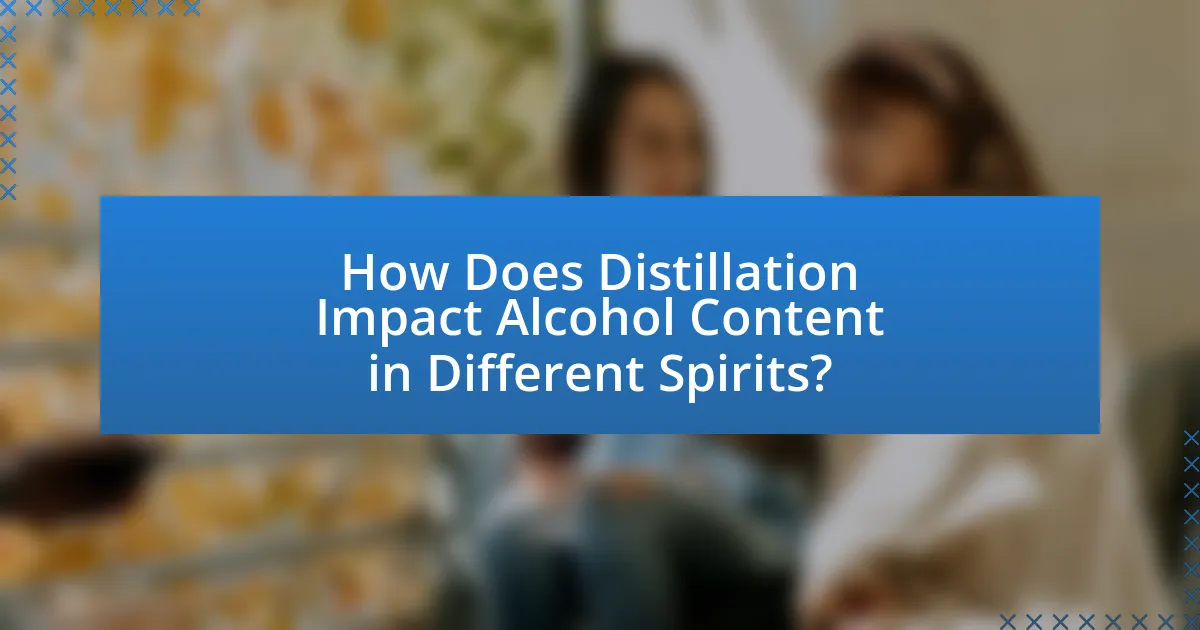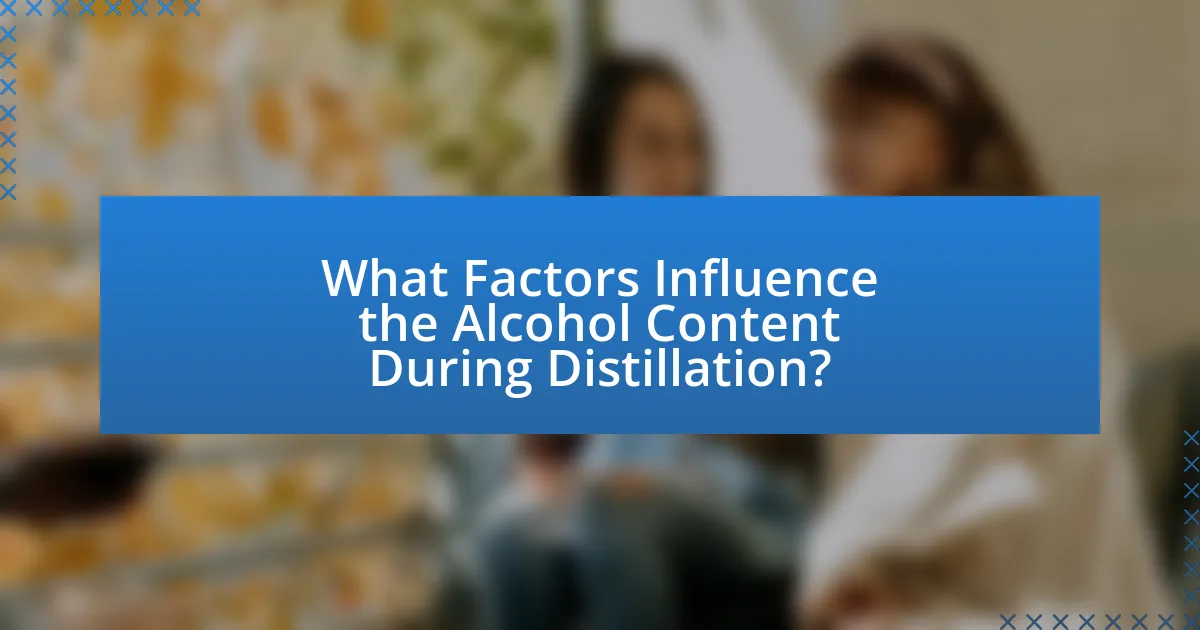Distillation is a critical process in alcohol production that separates ethanol from fermented mixtures by utilizing differences in boiling points. This article explores how distillation increases alcohol content in spirits such as whiskey, vodka, and rum, detailing the key processes involved, including heating, vaporization, condensation, and collection. It examines the impact of various distillation methods, such as pot still and column still techniques, on the purity and flavor profile of the final product, as well as the influence of factors like temperature, pressure, and raw materials on alcohol concentration. Additionally, the article highlights best practices for distillers to optimize alcohol yields while maintaining quality.

What is Distillation and Its Role in Alcohol Production?
Distillation is a separation process that involves heating a liquid to create vapor and then cooling the vapor to produce a liquid, primarily used in alcohol production to concentrate and purify alcoholic beverages. This method allows for the extraction of ethanol from fermented mixtures, increasing the alcohol content by separating it from water and other components based on differing boiling points. For instance, ethanol boils at approximately 78.37°C, while water boils at 100°C, enabling distillers to selectively vaporize and condense ethanol, resulting in spirits with higher alcohol concentrations. Historical evidence shows that distillation has been utilized since at least the 8th century, significantly impacting the production of various alcoholic beverages, including whiskey, vodka, and rum.
How does distillation work in the context of spirits?
Distillation in the context of spirits is a process that separates alcohol from a fermented mixture based on differences in boiling points. During distillation, the fermented liquid, known as the wash, is heated in a still, causing the alcohol to vaporize at a lower temperature than water. The vapor is then collected and cooled, condensing back into liquid form, resulting in a higher concentration of alcohol. This method effectively increases the alcohol content, as seen in spirits like whiskey and vodka, which can reach alcohol by volume (ABV) levels of 40% or higher, compared to the original wash, which typically contains around 8-12% ABV.
What are the key processes involved in distillation?
The key processes involved in distillation are heating, vaporization, condensation, and collection. Heating involves raising the temperature of a liquid mixture to its boiling point, causing the more volatile components to vaporize. Vaporization occurs when the liquid transforms into vapor, separating the components based on their boiling points. Condensation follows, where the vapor cools and returns to liquid form, typically in a condenser. Finally, collection involves gathering the condensed liquid, which contains a higher concentration of the desired component, such as alcohol in spirits. This process effectively separates substances based on their volatility, enhancing the alcohol content in the final product.
How do temperature and pressure influence distillation?
Temperature and pressure significantly influence distillation by affecting the boiling points of liquids. Higher temperatures increase the vaporization of components, allowing for more efficient separation of alcohol from water and other substances in the mixture. Conversely, lower pressure reduces the boiling point of liquids, enabling distillation to occur at lower temperatures, which can help preserve delicate flavors in spirits. For example, vacuum distillation operates at reduced pressure, allowing distillation of sensitive compounds without thermal degradation, thus enhancing the quality of the final product.
Why is distillation important for alcohol content?
Distillation is crucial for determining alcohol content because it separates alcohol from other components in a liquid mixture, concentrating the ethanol. This process relies on the different boiling points of substances; ethanol evaporates at a lower temperature than water, allowing for its extraction. For example, in the production of whiskey, distillation can increase the alcohol by volume (ABV) significantly, often reaching levels above 40%, which is essential for the spirit’s flavor profile and preservation.
What is the relationship between distillation and alcohol concentration?
Distillation directly increases alcohol concentration by separating alcohol from water and other components based on their boiling points. During the distillation process, the mixture is heated, causing alcohol to vaporize at a lower temperature than water. As the vapor rises, it is collected and cooled, condensing back into liquid form, which results in a higher concentration of alcohol in the distillate compared to the original mixture. This method is widely used in the production of spirits, where the alcohol content can be significantly elevated, often reaching levels above 40% by volume, depending on the number of distillation cycles performed.
How does distillation affect the flavor profile of spirits?
Distillation significantly alters the flavor profile of spirits by concentrating desirable compounds while removing unwanted ones. During the distillation process, the heating of the fermented liquid causes the alcohol and volatile flavor compounds to evaporate, which are then condensed back into liquid form. This selective evaporation allows for the retention of specific flavors, such as esters and phenols, which contribute to the spirit’s aroma and taste. For example, in whiskey production, the distillation process can enhance the caramel and vanilla notes derived from the aging process in wooden barrels, while also stripping away harsher, undesirable flavors. The result is a more refined and complex flavor profile that is characteristic of high-quality spirits.

How Does Distillation Impact Alcohol Content in Different Spirits?
Distillation significantly increases the alcohol content in different spirits by separating alcohol from water and other components through heating and cooling processes. During distillation, the mixture is heated to evaporate alcohol, which has a lower boiling point than water, allowing it to be collected and condensed back into liquid form. This process results in spirits like whiskey, vodka, and rum having higher alcohol by volume (ABV) percentages, typically ranging from 40% to 60% ABV, compared to fermented beverages like beer or wine, which usually contain around 4% to 15% ABV. The efficiency of distillation and the number of distillation cycles directly influence the final alcohol concentration, with multiple distillations yielding purer and stronger spirits.
What are the differences in distillation methods for various spirits?
Distillation methods for various spirits differ primarily in their techniques and equipment, which directly influence the flavor, purity, and alcohol content of the final product. For example, pot still distillation, commonly used for whiskey and rum, involves batch processing where the wash is heated in a pot, allowing for a richer flavor profile due to the retention of congeners. In contrast, column still distillation, often employed for vodka and gin, utilizes continuous distillation in a column, resulting in a higher alcohol content and a cleaner taste by removing more impurities. Additionally, the number of distillation runs can vary; for instance, some gins undergo multiple distillations to achieve desired flavor clarity, while some rums may be distilled only once to preserve their character. These differences in distillation methods are crucial as they determine the spirit’s final characteristics, including its alcohol by volume (ABV) and overall sensory profile.
How does pot still distillation differ from column still distillation?
Pot still distillation differs from column still distillation primarily in the method of separation and the resulting alcohol purity. Pot stills operate in a batch process, where the fermented mash is heated in a single vessel, allowing for a more complex flavor profile but typically resulting in lower alcohol content, usually around 60-70% ABV. In contrast, column stills utilize a continuous process with multiple plates or columns that facilitate repeated distillation, leading to higher alcohol purity, often exceeding 90% ABV. This difference in design and operation directly impacts the flavor and strength of the spirits produced, with pot stills favoring richer, more robust flavors and column stills producing cleaner, more neutral spirits.
What effects do different distillation techniques have on alcohol content?
Different distillation techniques significantly affect alcohol content by influencing the purity and concentration of the final product. For instance, pot still distillation typically results in lower alcohol content due to its batch process and less efficient separation of alcohol from other compounds, often yielding spirits around 40-50% ABV (alcohol by volume). In contrast, column still distillation, which employs continuous distillation and multiple plates, can achieve higher alcohol concentrations, often exceeding 90% ABV, by allowing for more effective separation of alcohol from impurities. This difference is evidenced by the production of high-proof spirits like vodka and gin, which utilize column stills to maximize alcohol content while minimizing congeners.
How does the number of distillation runs affect alcohol concentration?
The number of distillation runs directly increases alcohol concentration in spirits. Each distillation run separates alcohol from water and other components, resulting in a higher purity of alcohol with each cycle. For example, a single distillation may yield an alcohol concentration of around 20-30%, while multiple distillations can elevate this concentration to 60% or higher, depending on the initial mixture and the distillation method used. This process is supported by the principle of fractional distillation, where the boiling points of different components are exploited to achieve higher concentrations of the desired substance.
What is the impact of multiple distillation cycles on purity and strength?
Multiple distillation cycles significantly enhance the purity and strength of spirits. Each cycle removes impurities and volatile compounds, leading to a higher concentration of the desired alcohol. For instance, spirits like vodka often undergo multiple distillation processes to achieve a purity level of 95% alcohol by volume, effectively eliminating congeners and other unwanted substances. This process not only increases the alcohol content but also results in a smoother taste profile, as evidenced by the production methods of premium brands that emphasize high distillation counts to achieve superior quality.
How does the distillation process vary between whiskey, vodka, and rum?
The distillation process varies significantly between whiskey, vodka, and rum due to differences in ingredients, fermentation, and distillation techniques. Whiskey is typically distilled from fermented grain mash, which can include barley, corn, rye, or wheat, and is usually distilled twice in pot stills or column stills, resulting in a spirit with a rich flavor profile and an alcohol content of around 40-50%. Vodka, on the other hand, is often distilled from grains or potatoes and undergoes multiple distillations, sometimes up to five or more, to achieve a high purity level and a neutral flavor, typically resulting in an alcohol content of 40% or higher. Rum is distilled from sugarcane juice or molasses and can be distilled in pot stills or column stills, with the distillation process affecting its sweetness and flavor; rum generally has an alcohol content ranging from 37.5% to 50%. These variations in raw materials and distillation methods directly influence the final characteristics and alcohol content of each spirit.

What Factors Influence the Alcohol Content During Distillation?
The alcohol content during distillation is influenced by several key factors, including the initial fermentation process, the type of distillation apparatus used, and the distillation temperature. The fermentation process determines the amount of alcohol produced from the raw materials, with higher sugar content leading to higher alcohol levels. The type of distillation apparatus, such as pot stills or column stills, affects the separation efficiency of alcohol from other components; column stills typically yield higher alcohol concentrations due to continuous distillation. Additionally, the distillation temperature plays a critical role; higher temperatures can lead to greater evaporation of alcohol, but may also result in the loss of desirable flavors and compounds. These factors collectively dictate the final alcohol content in the distilled spirit.
How do raw materials affect the distillation process?
Raw materials significantly influence the distillation process by determining the composition and quality of the final product. The type of raw material, such as grains, fruits, or sugarcane, affects the fermentation process, which in turn impacts the alcohol yield and flavor profile. For instance, grains like barley produce different congeners compared to fruits like grapes, leading to distinct characteristics in the distilled spirit. Additionally, the sugar content in raw materials directly correlates with the potential alcohol content; higher sugar levels typically result in higher alcohol yields during fermentation. Studies have shown that the choice of raw materials can alter the boiling points of the components, affecting separation efficiency during distillation.
What role do fermentation and yeast play in alcohol production?
Fermentation and yeast are essential in alcohol production as they convert sugars into alcohol and carbon dioxide through metabolic processes. Yeast, specifically Saccharomyces cerevisiae, is the primary microorganism used in fermentation, where it consumes sugars present in the raw materials, such as grains or fruits, and produces ethanol as a byproduct. This process typically occurs in anaerobic conditions, where the absence of oxygen allows yeast to efficiently convert sugars into alcohol. Historical evidence shows that fermentation has been utilized for thousands of years, with archaeological findings indicating its use in ancient civilizations for producing alcoholic beverages.
How does the choice of ingredients impact the final alcohol content?
The choice of ingredients significantly impacts the final alcohol content in spirits by determining the sugar content available for fermentation. Ingredients such as grains, fruits, or sugarcane contain varying levels of fermentable sugars, which directly influence the amount of alcohol produced during fermentation. For example, high-sugar fruits like grapes can yield higher alcohol content compared to grains with lower sugar levels. Additionally, the type of yeast used in fermentation can affect the efficiency of sugar conversion to alcohol, further influencing the final alcohol percentage. Studies have shown that different yeast strains can produce varying alcohol levels from the same sugar source, highlighting the critical role of ingredient selection in the distillation process.
What environmental factors can influence distillation outcomes?
Environmental factors such as temperature, pressure, humidity, and altitude can significantly influence distillation outcomes. For instance, higher temperatures can increase the volatility of compounds, leading to a higher concentration of alcohol in the distillate. Conversely, lower temperatures may result in a more selective separation of components, affecting flavor profiles. Pressure variations can alter boiling points, impacting the efficiency of the distillation process. Additionally, humidity can affect the water content in the feedstock, which may influence the overall yield and purity of the distillate. Altitude also plays a role, as reduced atmospheric pressure at higher elevations lowers boiling points, which can change the distillation dynamics and the final alcohol content in spirits.
How does altitude affect the boiling point during distillation?
Altitude decreases the boiling point during distillation due to lower atmospheric pressure. At higher elevations, the reduced pressure allows liquids to boil at lower temperatures, which can affect the efficiency and outcome of the distillation process. For example, at sea level, water boils at 100 degrees Celsius, but at an altitude of 2,000 meters, the boiling point drops to approximately 93.4 degrees Celsius. This change can lead to variations in the separation of components in the distillation process, potentially impacting the alcohol content and flavor profile of spirits produced at higher altitudes.
What are the effects of humidity and temperature on distillation efficiency?
Humidity and temperature significantly impact distillation efficiency by influencing the vapor-liquid equilibrium and the boiling point of the substances involved. Higher humidity can lead to increased water vapor in the distillation environment, which may dilute the alcohol content and reduce the overall efficiency of separation. Conversely, elevated temperatures generally enhance the volatility of the components, allowing for more effective distillation by promoting the transition of liquid to vapor. For instance, a study published in the Journal of Food Engineering found that optimizing temperature during distillation can improve the extraction of volatile compounds, thereby increasing the efficiency of alcohol separation.
What are the best practices for achieving desired alcohol content in spirits?
To achieve the desired alcohol content in spirits, distillers should carefully control the distillation process, including the selection of raw materials, fermentation conditions, and distillation techniques. The choice of ingredients, such as the type of grains or fruits, influences the initial sugar content, which directly affects the potential alcohol yield. Maintaining optimal fermentation temperatures and yeast health ensures maximum conversion of sugars to alcohol. During distillation, using a pot still or column still allows for precise control over the separation of alcohol from other compounds, enabling distillers to target specific alcohol percentages. Additionally, monitoring the distillation cuts—heads, hearts, and tails—ensures that only the desired alcohol fraction is collected, which can significantly impact the final alcohol content. These practices are supported by the fact that distillation efficiency can vary based on the still design and operating conditions, as outlined in research by the American Distilling Institute, which emphasizes the importance of these factors in achieving consistent alcohol levels.
How can distillers optimize their processes for higher alcohol yields?
Distillers can optimize their processes for higher alcohol yields by implementing precise temperature control during fermentation and distillation. Maintaining optimal fermentation temperatures enhances yeast activity, leading to more efficient sugar conversion into alcohol. Additionally, using advanced distillation techniques, such as fractional distillation, allows for better separation of alcohol from other components, maximizing the alcohol concentration in the final product. Research indicates that controlling these variables can increase yields by up to 20%, demonstrating the effectiveness of these optimization strategies.
What common mistakes should be avoided during distillation to maintain quality?
Common mistakes to avoid during distillation to maintain quality include improper temperature control, which can lead to undesirable compounds being vaporized, and inadequate separation of fractions, resulting in off-flavors. Additionally, using contaminated equipment can introduce impurities, while rushing the distillation process may prevent the full extraction of desired flavors and aromas. These mistakes can compromise the overall quality of the distilled spirits, as evidenced by studies showing that precise temperature management and proper fractionation are critical for achieving high-quality distillates.


